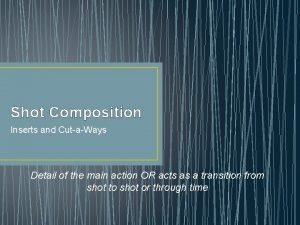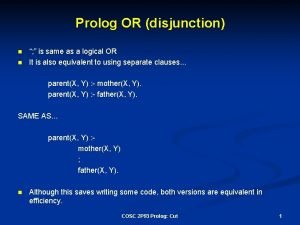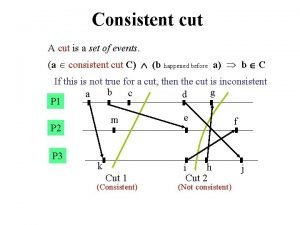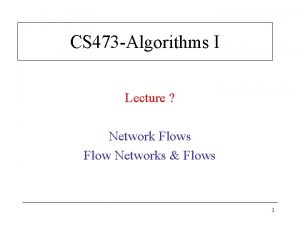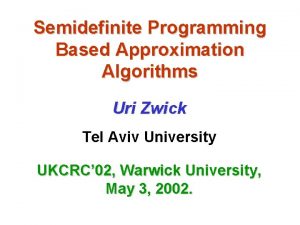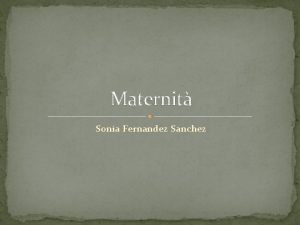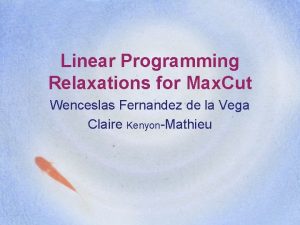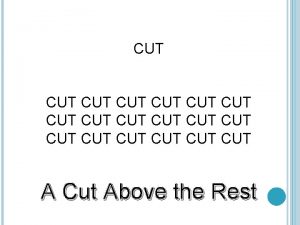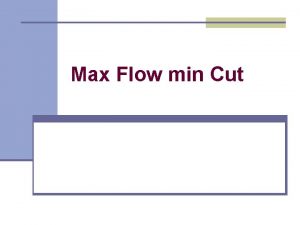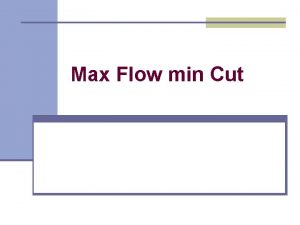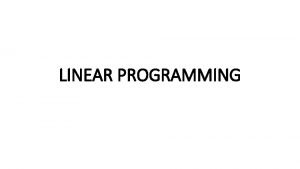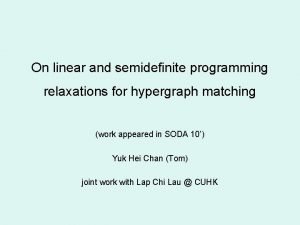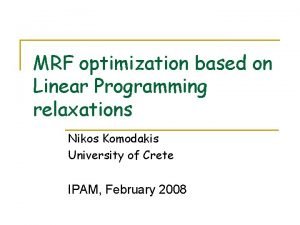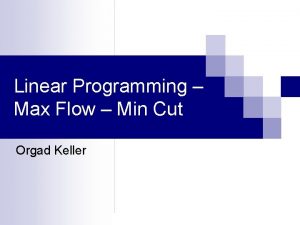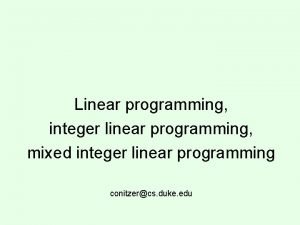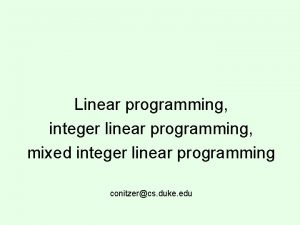Linear Programming Relaxations for Max Cut Wenceslas Fernandez



![Lift and Project (L&P) [BCC, LS, SA, L] Systematic way to strengthen LPs. Rounds: Lift and Project (L&P) [BCC, LS, SA, L] Systematic way to strengthen LPs. Rounds:](https://slidetodoc.com/presentation_image_h2/6ac38b85c7eec82ee3e8274b4389a98e/image-4.jpg)

![L&P for Max. Cut • LP relaxation has gap=2 [PT’ 94] • Thm [here]: L&P for Max. Cut • LP relaxation has gap=2 [PT’ 94] • Thm [here]:](https://slidetodoc.com/presentation_image_h2/6ac38b85c7eec82ee3e8274b4389a98e/image-6.jpg)









![Positive results Without SDP, is L&P actually useful? Thm [here]: in dense graphs, gap~1 Positive results Without SDP, is L&P actually useful? Thm [here]: in dense graphs, gap~1](https://slidetodoc.com/presentation_image_h2/6ac38b85c7eec82ee3e8274b4389a98e/image-16.jpg)



![Proof(1/1) based on [AFKK] Proof(1/1) based on [AFKK]](https://slidetodoc.com/presentation_image_h2/6ac38b85c7eec82ee3e8274b4389a98e/image-20.jpg)


- Slides: 22

Linear Programming Relaxations for Max. Cut Wenceslas Fernandez de la Vega Claire Kenyon-Mathieu

Technique for approximation § § IP formulation with 0 -1 variables LP relaxation algorithm Strengthen LP: add valid inequalities Reduce integrality gap = § Better approximation

Example: Min Cost Perfect (non-bipartite) Matching Unbounded gap LP: Edge e is taken with probability x(e) Every vertex has exactly one adjacent edge [Edmonds 1965] Reduce gap to 1 by adding: Every odd vertex set has at least one edge to the outside
![Lift and Project LP BCC LS SA L Systematic way to strengthen LPs Rounds Lift and Project (L&P) [BCC, LS, SA, L] Systematic way to strengthen LPs. Rounds:](https://slidetodoc.com/presentation_image_h2/6ac38b85c7eec82ee3e8274b4389a98e/image-4.jpg)
Lift and Project (L&P) [BCC, LS, SA, L] Systematic way to strengthen LPs. Rounds: • After 0 rounds: basic LP • After k rounds: contains all valid inequalities with support k • After n rounds: IP Poly-time solvable for any fixed k.

L&P and int gaps • Vertex cover [KG’ 98, AB, L’ 02, C’ 02 STT’ 06] • Max 3 SAT, Set cover, Hypergraph vertex cover [BOGH+03, AAT 05] Here: Maxcut Because: Theory people like Maxcut!
![LP for Max Cut LP relaxation has gap2 PT 94 Thm here L&P for Max. Cut • LP relaxation has gap=2 [PT’ 94] • Thm [here]:](https://slidetodoc.com/presentation_image_h2/6ac38b85c7eec82ee3e8274b4389a98e/image-6.jpg)
L&P for Max. Cut • LP relaxation has gap=2 [PT’ 94] • Thm [here]: gap is still 2 even after log(n)ˆc rounds of Sherali-Adams L&P • Thm [STT]: (for another LP) gap is still 2 even after a linear number of rounds of Lovasz. Shrijver L&P. • The moral: for Max. Cut, SDP is better than LP, even if the LPs are greatly enhanced.

Questions • Definition of L&P? • Differences Lovasz-Shrijver vs. Sherali. Adams vs. others? • SDP variant of L&P? • Compare proof to other lower bound proofs for L&P? No answers in this talk.

What I like about this work Not the result: somewhat unsurprising Not the “broader impacts”… The proof: Relatively clean: few short calculations, all driven by intuition Next: some key ideas for a simple case No need to know about lift and project!

Max. Cut LP relaxation… • x(i, j) indicates whether {i, j} crosses the cut x(i, j)+x(j, k)+x(k, i) ≤ 2 x(i, j) ≤ x(j, k)+x(k, i) i j • Gap = 2 k

… enhanced • Additional valid inequalities: a b d e I cut at most 6 edges c x(a, b)+x(a, c)+…+x(d, e) ≤ 6 • We will prove that we still have Gap = 2.

• Graph: sparse random, altered for large girth. Gap=2! • Max. Cut ≈|E|/2 w. h. p. • To define x(i, j): threshold T. if distance > T then x(i, j)=1/2; else, construct a random labeling on the shortest path, and let x(i, j)=Pr(labels differ). • Such that x(i, j)=1 - for i and j adjacent FRAC ≈ |E|

Core of proof: feasibility • (x(i, j)) satisfies every constraint: let S be the vertices involved in ax-b 0. • Define a distribution over labels of S only, and let y(i, j)=Pr(labels differ). • y is a fractional cut, and constraint is valid inequality, so by definition ay-b ≥ 0: no calculations needed for this! • Observe that y(i, j) ≈ x(i, j) • Thus: ax-b ≈ ay-b ≥ 0.

Defining x(i, j) •

Defining y(i, j) when S={i, j, k, u, v} •

Coupling x(i, j) and y(i, j) •
![Positive results Without SDP is LP actually useful Thm here in dense graphs gap1 Positive results Without SDP, is L&P actually useful? Thm [here]: in dense graphs, gap~1](https://slidetodoc.com/presentation_image_h2/6ac38b85c7eec82ee3e8274b4389a98e/image-16.jpg)
Positive results Without SDP, is L&P actually useful? Thm [here]: in dense graphs, gap~1 after O(1) rounds of Sherali-Adams L&P Note: this is not surprising since there already exist at least 3 PTAS for Max. Cut in dense graphs.

Conclusion • L&P is potentially an attractive alternative to ad hoc fumbling with existing LPs • Unfortunately, most results so far are negative if we don’t use SDP. • To justify continued work on L&P, we need some positive results: for some problem, find a new, better approximation algorithm by using L&P explicitly and voluntarily.

That’s it • The end

Makespan minimization • Independent jobs, m parallel machines • LP: x(i, j) indicates whether job j goes on machine i, and t=makespan. Constraints: Every job must go on some machine Makespan greater than load on each machine • Unbounded gap • Add: “makespan≥p(j) for every job” reduces gap to 2, but this does not appear in L&P until after m rounds.
![Proof11 based on AFKK Proof(1/1) based on [AFKK]](https://slidetodoc.com/presentation_image_h2/6ac38b85c7eec82ee3e8274b4389a98e/image-20.jpg)
Proof(1/1) based on [AFKK]


Proof(4/4) • Given S set of 5 vertices or less, define (y(i, j)) over cuts of S • Subgraph H(S)={edges on some i-to-j path with i, j in S and distance < T} • Large girth H(S) is a forest • Remove each edge of H(S) w. p. 2 independently; In each connected component, label vertices alternating 1 and 0 from a random starting point Set Y(i, j)=1 iff i and j have different labels. set y(i, j)=Expectation of Y(i, j).
 Tableau des relaxations dynamiques
Tableau des relaxations dynamiques Wenceslas liechtenstein
Wenceslas liechtenstein Perbedaan linear programming dan integer programming
Perbedaan linear programming dan integer programming Linear vs integer programming
Linear vs integer programming Programing adalah
Programing adalah Cut away camera shot
Cut away camera shot Prolog or
Prolog or Rip cut vs cross cut
Rip cut vs cross cut Consistent cut
Consistent cut Flow g cut
Flow g cut Max cut
Max cut Max flow min cut algorithm
Max flow min cut algorithm Local minimum
Local minimum Difference between delirium and dementia ppt
Difference between delirium and dementia ppt Carlos fajardo casajús
Carlos fajardo casajús Thalia fernandez
Thalia fernandez Parking lot of the personality disordered
Parking lot of the personality disordered Daniel fernández de landa
Daniel fernández de landa Isabel fernandez garcia
Isabel fernandez garcia Candela quiroga fernandez
Candela quiroga fernandez Ime rudy fernandez
Ime rudy fernandez Roberto fernandez md
Roberto fernandez md Sonia fernandez sanchez
Sonia fernandez sanchez





